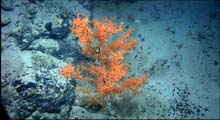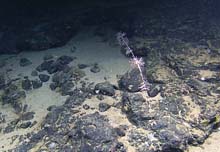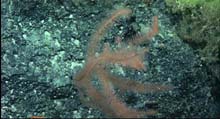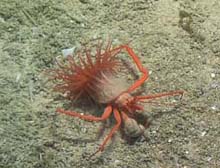
Bushy black coral (Leiopathes sp.) collected from 1643m depth on Bear Seamount. This particular black coral expels a large amount of mucus when agitated. Within the New England Seamount chain, very few associates have been found living on the bushy black coral. Click image for larger view and image credit.
A hermit crab crawls along the sediment with an anemone hitching a ride. These anemones will live on the shells of the hermit crabs forever. This relationship is beneficial for both parties, the crab gets the protection of the anemones stinging cells, and the anemone is moved around to different places, so maximizes the chances of getting enough food.
Linnaean Terminology With A Twist!
August 14, 2005
Mercer Brugler
Graduate Student
University of Louisiana at Lafayette
Carl Linnaeus? Who's Carl Linnaeus? Does binomial nomenclature ring a bell? If you've ever seen an organism's scientific name (e.g., Homo sapiens , or human), you've encountered the influence of Carl Linnaeus. Dr. Linnaeus added a hierarchical order, with a Latin twist, to the naming of all organisms in the world. Have you ever heard of the phrase King Phillip Came Over From Geneva Switzerland? Many school children are taught phrases or jingles to help remember Linnaeus' hierarchical order: Kingdom, Phylum, Class, Order, Genus, Species. By assigning every organism in the world a specific genus and species name, we can keep them separated from one another, know who is related, or quickly reference them when the need arises. So why bring up Linnaeus on a deep-sea research cruise?
If Dr. Linnaeus were a fly on the wall of the ROV (Remotely Operated Vehicle) van, he would fall over dead. "Look, it's a groomed poodle," remarks one of the scientists as the ROV Hercules maneuvers over what would later be described as a juvenile Metallogorgia melanotrichos . After the ROV gets underway, another scientist says, "There's one of those candelabra corals ( Candidella imbricata )" or "It's another one of those grapefruit sponges." Even later in the same dive, "Would you please collect that big orange bushy black coral ( Leiopathes sp.)?" Do these phrases sound Linnaean (or specific to a particular organism) to you?

A juvenile groomed poodle coral (Metallogorgia melanotrichos) collected from 1491m depth on Bear Seamount. Click image for larger view and image credit.
The R/V Ron Brown currently houses some of the world's most specialized and knowledgeable deep-sea biologists, as well as the latest technology (high definition cameras, 52 inch flat-screen plasma televisions, and high speed computers), yet we oftentimes use common terminology to describe the organisms we encounter. Why? Imagine you're in the ROV van with fish and coral biologists, geologists, ROV pilots, and video technicians. Now imagine the ROV comes across ten corals and you call out "Look, its Parantipathes sp." Are the fish biologists going to know which coral you're referring to? Chances are they're not. Instead, we invent fun names that everyone can use to help describe the organism of interest. In the case of Parantipathes, it's better known among the scientists as the bottlebrush black coral (as opposed to the bottlebrush white coral, Thouarella sp. !) Believe it or not, it actually resembles a bottlebrush that would be used in your Chemistry class to clean glassware.

The branched bottlebrush black coral (Parantipathes sp.) collected from Lyman Seamount (part of the Corner Rise Seamount chain). Unbranched forms of the bottlebrush also occur, oftentimes with two or more chirostyliead crabs living on the colony. Click image for larger view and image credit.

Bottlebrush white coral (Thouarella sp.) collected from 1458m depth on Manning Seamount. The bottlebrush white corals are often branched, with each branch containing hundreds of individual mouths, or polyps. Click image for larger view and image credit.
There is another reason, and perhaps a more important one, for why we use common terms to describe the corals we encounter at sea. Quite frankly, we do not know their true scientific, or Linnaean, name until we get back to the lab and conduct numerous analyses. But don't let our fun names fool you. Many corals in the deep-sea look like bottlebrushes, or candelabras, thus, it is of utmost importance that a unique name be given to each and every specimen, a Linnaean name to be exact.
It is not until much later after the cruise has come to an end that many of the organisms we collect actually acquire a true Linnaean name. But for now, we continue to use a plethora of descriptive names to identify the organisms we find.
Sign up for the Ocean Explorer E-mail Update List.

























